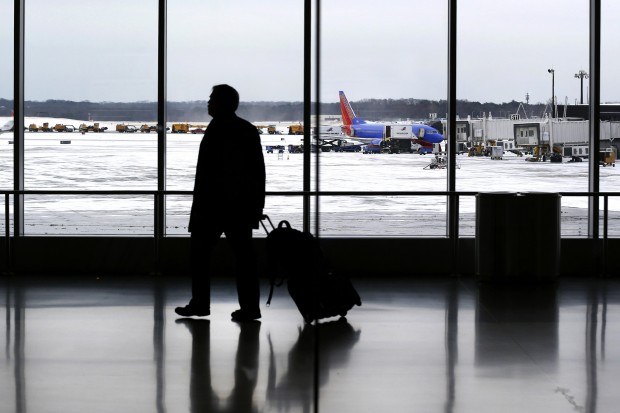Severe winter weather cost U.S. airline passengers $5.3 billion in expenses and missed workdays as carriers canceled and delayed trips in the worst period of flight disruption since Sept. 11.
The cost to airlines may be as much as $500 million on increased operating expenses and lost revenue, according to industry data tracker MasFlight. Cancellations from Dec. 1 through Feb. 28 totaled 108,600, almost double the average of previous winters of 57,600.
MasFlight’s estimate offers a glimpse at the economic toll from snow and storms that pummeled a broad swath of the country this winter, disrupting travel plans for more than 90 million people. United Continental Holdings Inc. has signaled a key revenue gauge will be lower this quarter as a result.
“This will be remembered as one of the worst winter storm periods in aviation history,” said Tulinda Larsen, vice president of Bethesda, Maryland-based MasFlight, in an interview.
And it’s not over. Yet another storm swooped through the mid-Atlantic yesterday, closing government offices and shutting schools. About 2,800 flights were canceled, according to FlightAware, for a total of more than 5,200 since the beginning of the month.
The storm is the latest in a season that has set many records and shows little sign of ending soon. January racked up more than 49,000 cancellations, as many as the past three Januaries combined, MasFlight said previously. Feb. 13 was the worst day of winter with 7,561 cancellations, topping the 7,400 on Oct. 29, 2012, that resulted from Hurricane Sandy.
Passenger Costs
MasFlight’s analysis is based on industry metrics for average passengers per aircraft and the costs to fliers. It used data from Airlines for America, the Federal Aviation Administration, the Department of Transportation and the Joint Economic Commission. These cost metrics found cancellations cost passengers $37.60 per hour, MasFlight said. Since the airlines are operating at such high load factors, accommodating displaced passengers is estimated to take an extra 18 hours of travel, MasFlight said, citing the General Accountability Office.
The flight cancellation rate this winter of 5.5 percent exceeded the last severe winter period of 2010-2011 of 4.3 percent, MasFlight said in a release today. The total cost to passengers this winter compares with a typical winter average of $2.9 billion and an average over the two previous winters of $1.5 billion.
Earlier Flights
Kat Robison, 29, takes advantage of advance travel advisories to ensure she can make her weekly trip to Pittsburgh from Raleigh, North Carolina, she said.
“I usually take a late morning flight on Wednesday, and I’ve ended up having to take an early morning flight to avoid a canceled flight or to get out before weather hits,” said Robison, who flies every week to attend graduate school at Youngstown State University in Ohio and returns every Friday morning.
Earlier flights in the morning mean that Robison has had to pay another $30 for an extra day for a rental car about three or four times this year, she said.
The costs from the continuous storms are piling up beyond airlines and passengers.
Insured losses, from frozen pipes, collapsed roofs and other weather-related incidents, reached more than $1.5 billion since Jan. 1, which would make this one of the top five costliest winters since 1980, according to the Insurance Information Institute in New York.
Airlines stand to lose money from the travelers who have canceled flights to one-time events like business conferences, said Helane Becker, an analyst with Cowen & Co. in New York.
“They’ll be able to get some of it back, but there is some of it that is lost forever,” she said.
Biggest Hubs
The storms affected the country’s biggest airline hubs, including airports in Chicago, Atlanta, and the busiest airspace in the U.S., the New York-New Jersey region, resulting in about $4.5 million in costs for airports, MasFlight said.
United, American Airlines Group Inc., US Airways Group Inc. and JetBlue Airways Corp. topped the list of cancellation rates during the period, MasFlight said.
United, the world’s second-largest airline, was the first airline to detail how the storms will affect its finances. It said last week that revenue for each seat flown a mile will decline this quarter because the winter storms caused more than 22,500 flights to be canceled.
New Rules
New operational regulations since the winter of 2009-2010 have also had a “profound impact” on flight completions and passengers, MasFlight said.
The Tarmac Rule, which became effective in April 2010 for domestic flights, limits the time an aircraft can spend taxiing, leading airlines to cancel flights to avoid fines of as much as $27,500. Deicing an aircraft can take as long as 45 minutes which can lead to violations of the delay rule, MasFlight said.
“With limited gate capacity available, airlines continue to cancel flights to best utilize available deicing and runway capacity,” MasFlight said in its release.
Another rule took effect Jan. 4 and limits pilots’ work hours.
“When the cusp of a significant adjustment like this coincides with serial bad weather across the country and a heavy holiday traffic period, it would be unrealistic to expect good things to happen,” said Bob Mann, a former American Airlines executive who is now president of aviation consultant R.W. Mann & Co. in Port Washington, New York, in an e-mailed response to questions. “And they didn’t, and in some cases didn’t for days.”
The harsh weather across the East Coast and Midwest created a ripple effect that reached California as airlines’ schedules, crews and aircraft logistics changed, Mann said.
“No place is immune to disruption, even if it seems remote to an actual weather event and disturbance,” he said.
–With assistance from Brian K. Sullivan in Boston. Editors: Molly Schuetz, John Lear




















 What Role Does Insurance Play in a Politically Charged Climate?
What Role Does Insurance Play in a Politically Charged Climate?  The Smart Workforce Pivot: Insurance’s Backdoor to Talent Acquisition
The Smart Workforce Pivot: Insurance’s Backdoor to Talent Acquisition  Study Finds Link Between Mass Layoffs and Data Breaches
Study Finds Link Between Mass Layoffs and Data Breaches  Trigger Warning: Cyber Policy Wordings to Impact Coverage for Tech Outage
Trigger Warning: Cyber Policy Wordings to Impact Coverage for Tech Outage 
